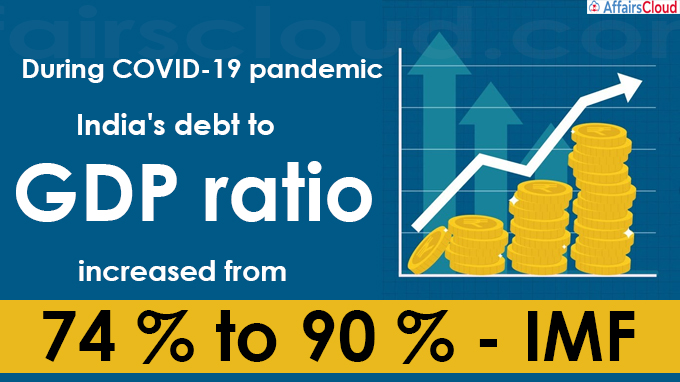
On April 7, 2021, the International Monetary Fund(IMF) reported an increase in India’s debt to Gross Domestic Product (GDP) ratio from 74 percent (at the end of 2019) to 90 percent (at the end of 2020) during the COVID-19 period.
- Based on the IMF’s baseline forecast, it expects a further drop in India’s ‘Debt to GDP ratio’ to 80 percent due to the recent Indian economy recovery.
Key points:
- IMF suggested India to support people and firms, and, in particular, the most vulnerable.
- Vitor Gaspar, Director of IMF’s Fiscal Affairs Department stated a worldwide increase in the widening deficits, contraction in economic activity and debt sharply to 97 percent of GDP in 2020 and it will increase slower to 99 percent in 2021 before stabilising below but close to 100 percent of GDP.
- The IMF mentioned that it stands ready to act and has a financial capacity of about USD 1 trillion when it is necessary to restore confidence in markets.
About Debt-to-GDP Ratio:
- The debt-to-GDP ratio is the ratio of a country’s public debt to its gross domestic product (GDP).
- By comparing what a country owes with what it produces, the debt-to-GDP ratio reliably indicates the particular country’s ability to pay back its debts it is often expressed as a percentage.
- The Formula: Debt to GDP= Total Debt of Country/Total GDP of Country.
- The increase in Debt to GDP ratio indicates that the country has weaker capacity to pay back its debt.
Recent Related News:
IMF in its World Economic Outlook, titled ‘Policy Support and Vaccines Expected to Lift Activity’ has projected India’s GDP to contract by 8%(-8%) in FY20-21. Earlier in its October’s forecast, this estimate was -10.3%. It also projected India’s GDP growth at 11.5% in FY 21-22
About International Monetary Fund (IMF):
Establishment– 1944
Member Countries– 190
Headquarter – Washington, D.C., United States
Managing Director – Kristalina Georgieva
Economic Counsellor and Research Department Director – Gita Gopinath




